emergency towing TOYOTA YARIS 2010 3.G Owners Manual
[x] Cancel search | Manufacturer: TOYOTA, Model Year: 2010, Model line: YARIS, Model: TOYOTA YARIS 2010 3.GPages: 400, PDF Size: 11.4 MB
Page 159 of 400

159 2-4. Using other driving systems
2
When driving
CAUTION
■To avoid operating the cruise control by mistake
Keep the ON-OFF button off when not in use.
■Situations unsuitable for cruise control
Do not use cruise control in any of the following situations.
Doing so may result in control of the vehicle being lost and could cause an
accident resulting in death or serious injury.
●In heavy traffic
●On roads with sharp bends
●On winding roads
●On slippery roads, such as those covered with rain, ice or snow
●On steep hills
Vehicle speed may exceed the set speed when driving down a steep hill.
●When towing a trailer or emergency towing
Page 305 of 400
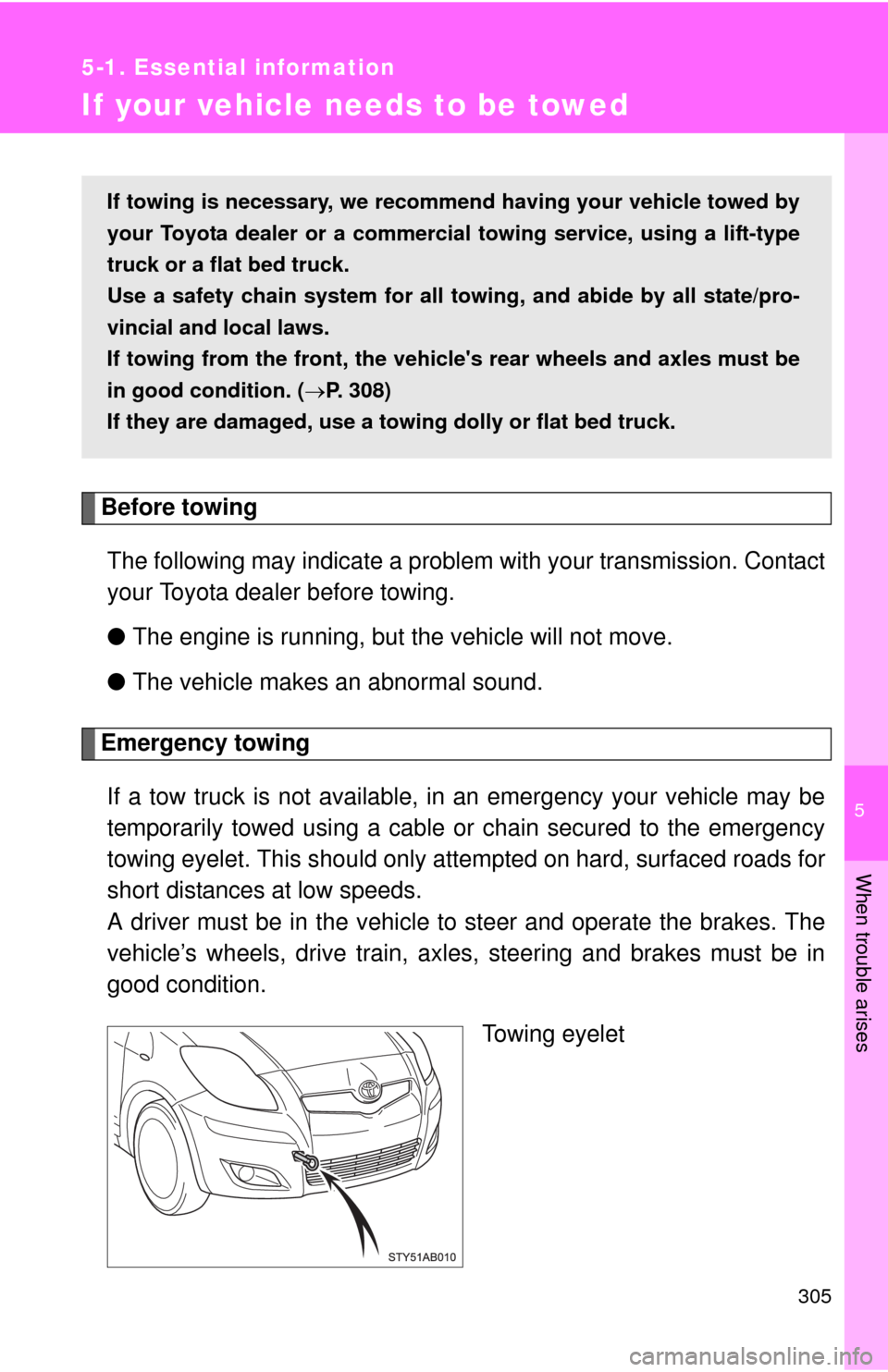
5
When trouble arises
305
5-1. Essential information
If your vehicle needs to be towed
Before towing
The following may indicate a problem with your transmission. Contact
your Toyota dealer before towing.
●The engine is running, but the vehicle will not move.
●The vehicle makes an abnormal sound.
Emergency towing
If a tow truck is not available, in an emergency your vehicle may be
temporarily towed using a cable or chain secured to the emergency
towing eyelet. This should only attempted on hard, surfaced roads for
short distances at low speeds.
A driver must be in the vehicle to steer and operate the brakes. The
vehicle’s wheels, drive train, axles, steering and brakes must be in
good condition.
Towing eyelet
If towing is necessary, we recommend having your vehicle towed by
your Toyota dealer or a commercial towing service, using a lift-type
truck or a flat bed truck.
Use a safety chain system for all towing, and abide by all state/pro-
vincial and local laws.
If towing from the front, the vehicle's rear wheels and axles must be
in good condition. (P. 308)
If they are damaged, use a towing dolly or flat bed truck.
Page 306 of 400
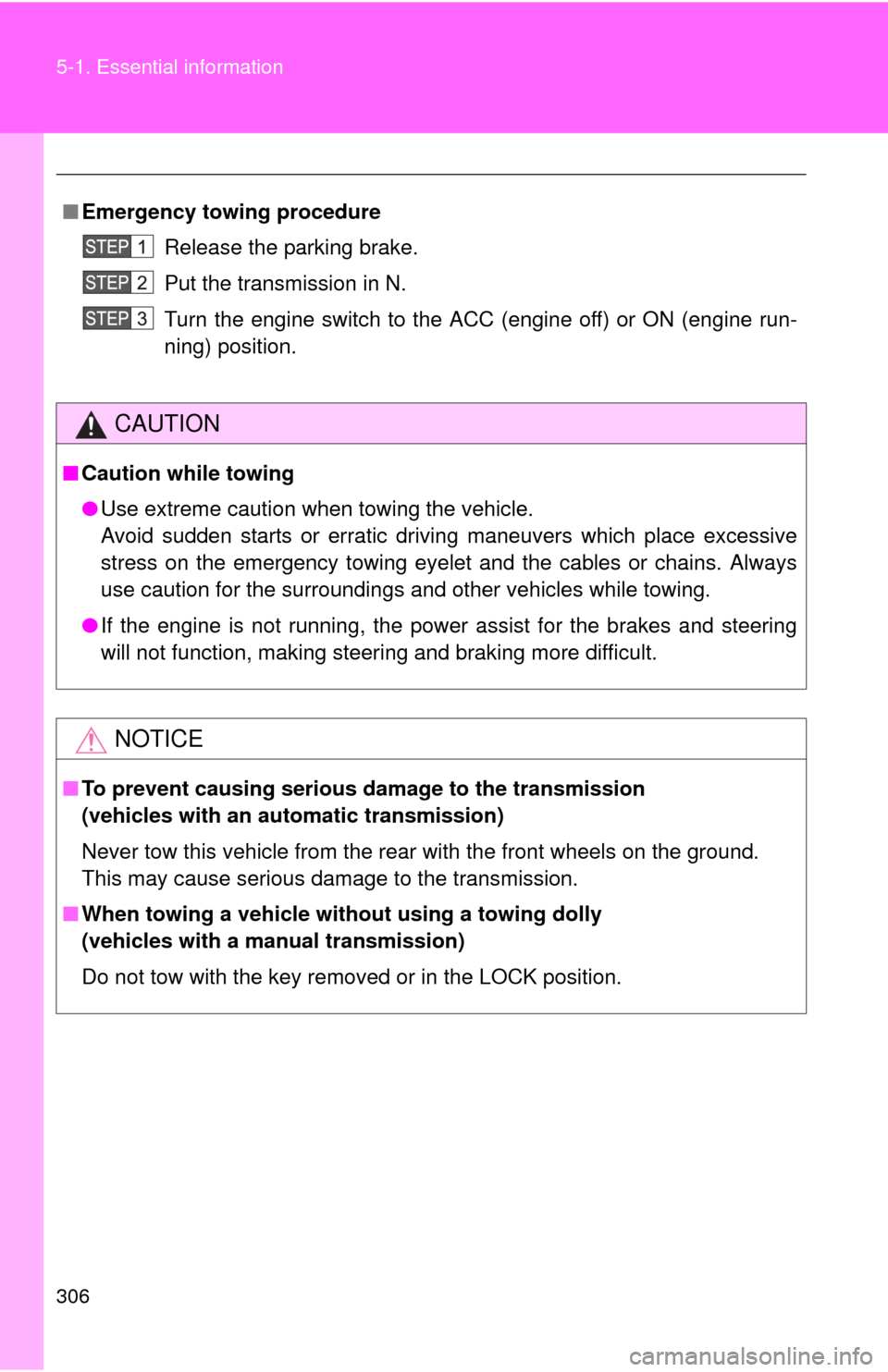
306 5-1. Essential information
■Emergency towing procedure
Release the parking brake.
Put the transmission in N.
Turn the engine switch to the ACC (engine off) or ON (engine run-
ning) position.
CAUTION
■Caution while towing
●Use extreme caution when towing the vehicle.
Avoid sudden starts or erratic driving maneuvers which place excessive
stress on the emergency towing eyelet and the cables or chains. Always
use caution for the surroundings and other vehicles while towing.
●If the engine is not running, the power assist for the brakes and steering
will not function, making steering and braking more difficult.
NOTICE
■To prevent causing serious damage to the transmission
(vehicles with an automatic transmission)
Never tow this vehicle from the rear with the front wheels on the ground.
This may cause serious damage to the transmission.
■When towing a vehicle without using a towing dolly
(vehicles with a manual transmission)
Do not tow with the key removed or in the LOCK position.
Page 307 of 400
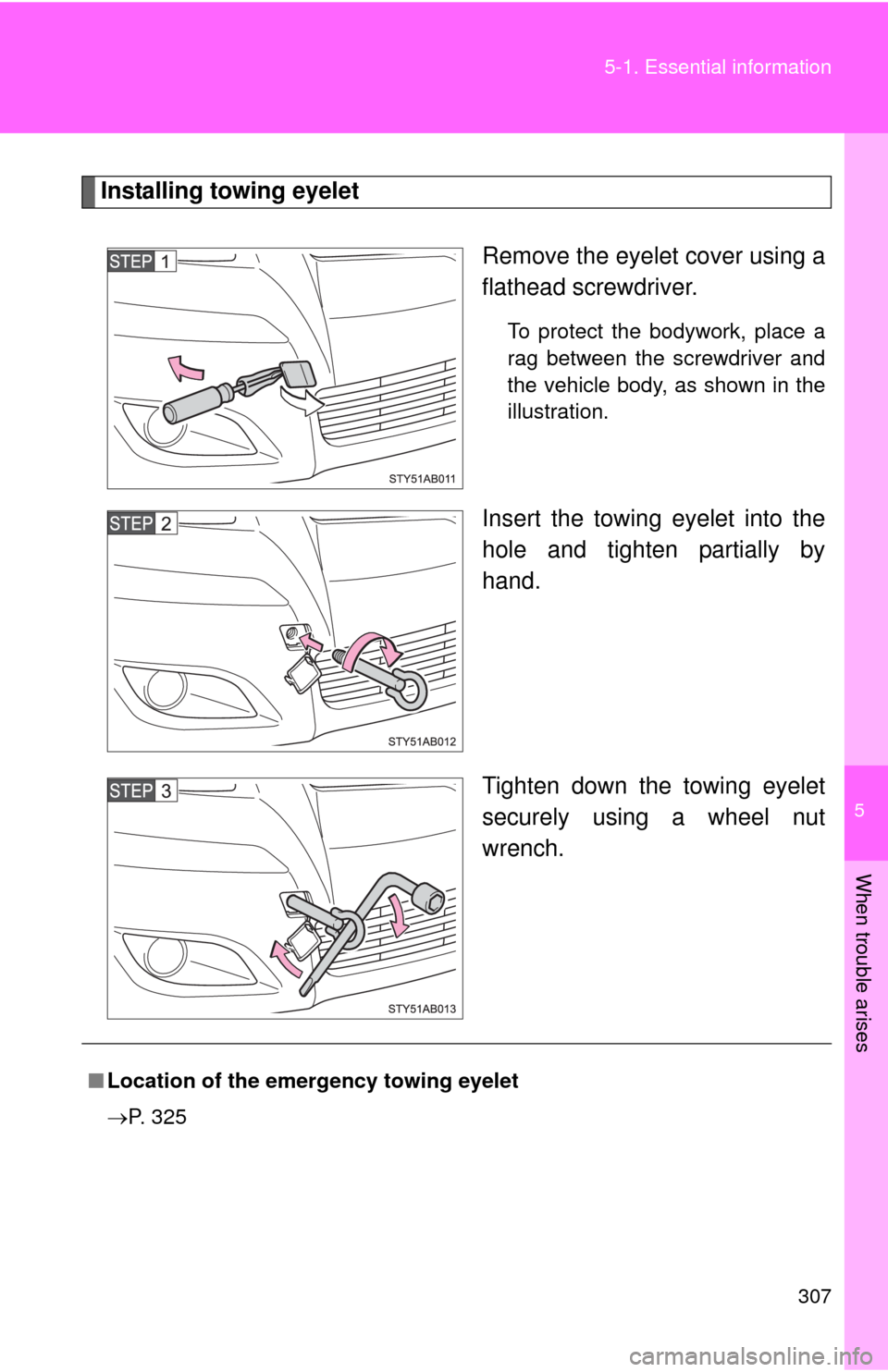
5
When trouble arises
307 5-1. Essential information
Installing towing eyelet
Remove the eyelet cover using a
flathead screwdriver.
To protect the bodywork, place a
rag between the screwdriver and
the vehicle body, as shown in the
illustration.
Insert the towing eyelet into the
hole and tighten partially by
hand.
Tighten down the towing eyelet
securely using a wheel nut
wrench.
■Location of the emergency towing eyelet
P. 325
Page 325 of 400
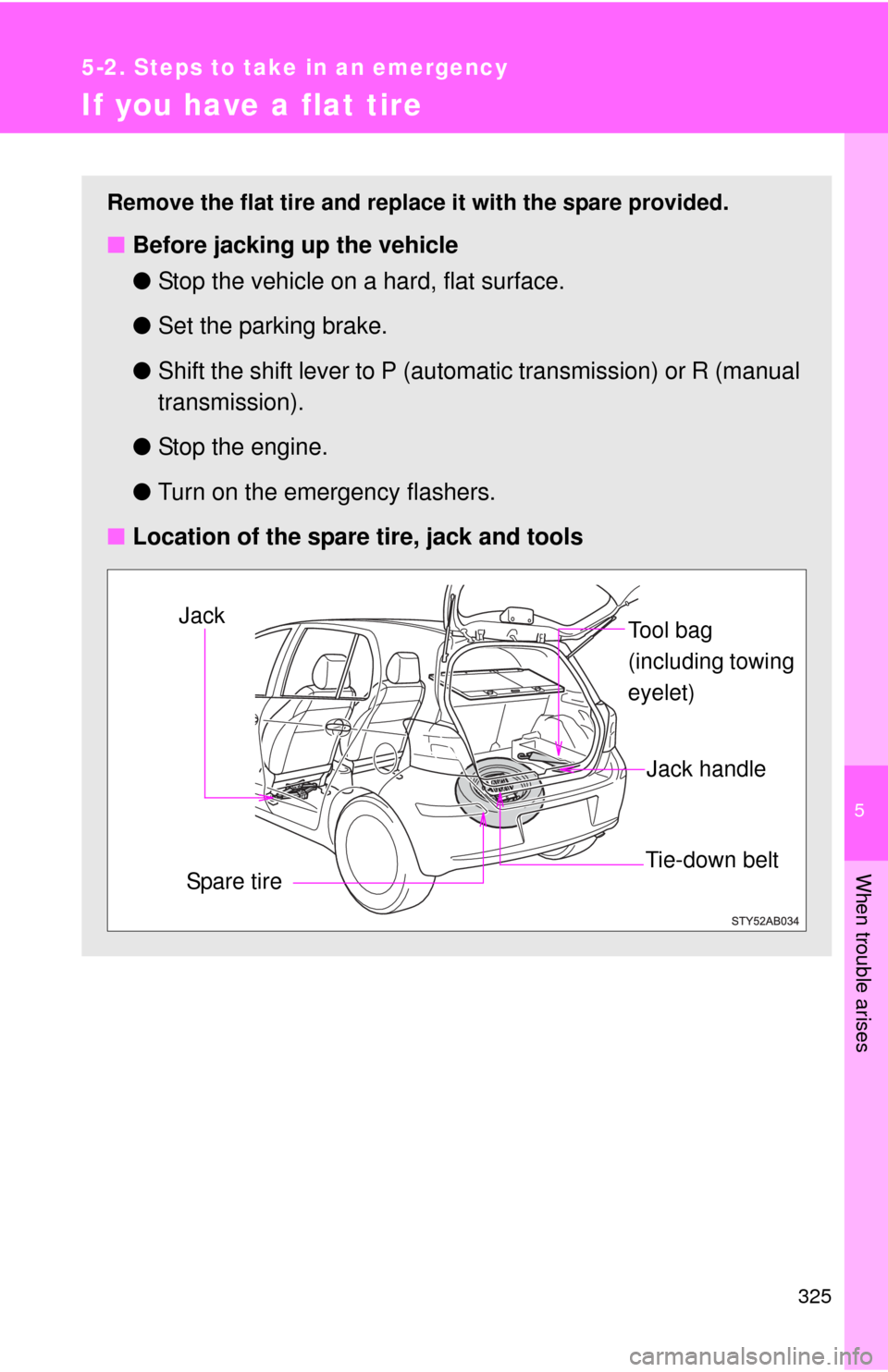
5
When trouble arises
325
5-2. Steps to take in an emergency
If you have a flat tire
Remove the flat tire and replace it with the spare provided.
■Before jacking up the vehicle
●Stop the vehicle on a hard, flat surface.
●Set the parking brake.
●Shift the shift lever to P (automatic transmission) or R (manual
transmission).
●Stop the engine.
●Turn on the emergency flashers.
■Location of the spare tire, jack and tools
Spare tire Jack
Jack handle
Tie-down belt
Tool bag
(including towing
eyelet)
Page 331 of 400
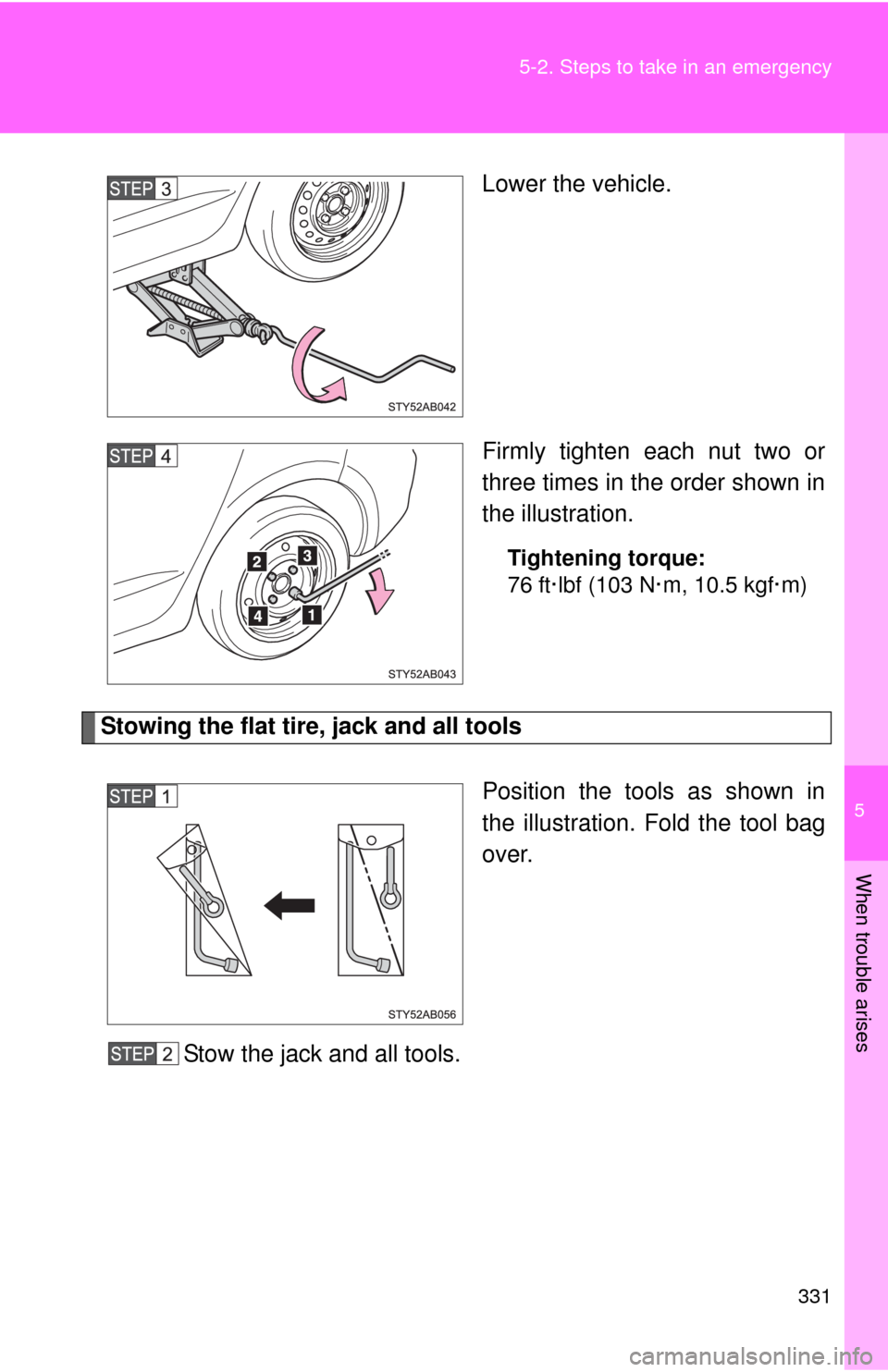
5
When trouble arises
331 5-2. Steps to take in an emergency
Lower the vehicle.
Firmly tighten each nut two or
three times in the order shown in
the illustration.
Tightening torque:
76 ft·lbf (103 N·m, 10.5 kgf·m)
Stowing the flat tire, jack and all tools
Position the tools as shown in
the illustration. Fold the tool bag
over.
Stow the jack and all tools.
Page 333 of 400
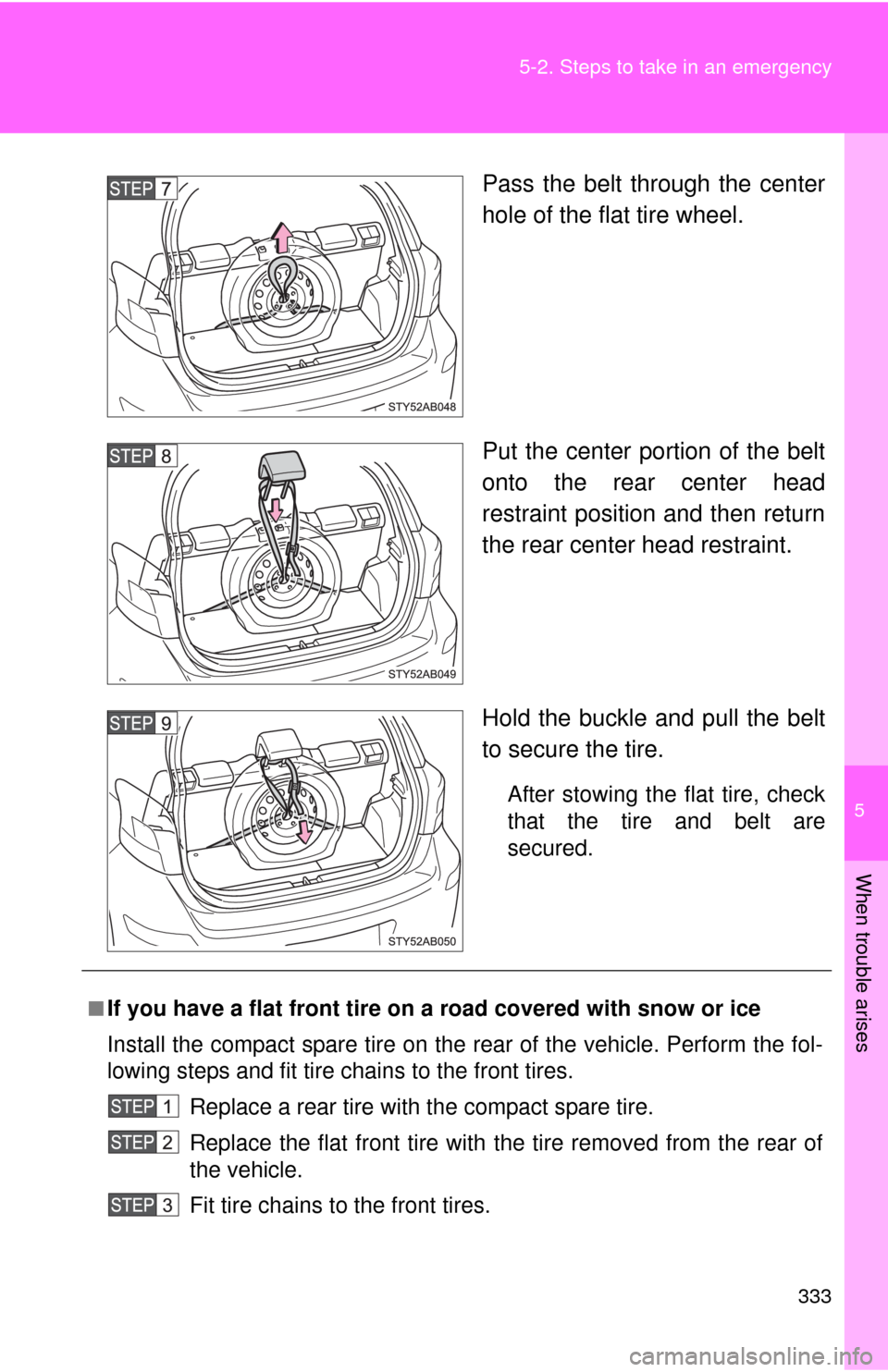
5
When trouble arises
333 5-2. Steps to take in an emergency
Pass the belt through the center
hole of the flat tire wheel.
Put the center portion of the belt
onto the rear center head
restraint position and then return
the rear center head restraint.
Hold the buckle and pull the belt
to secure the tire.
After stowing the flat tire, check
that the tire and belt are
secured.
■If you have a flat front tire on a road covered with snow or ice
Install the compact spare tire on the rear of the vehicle. Perform the fol-
lowing steps and fit tire chains to the front tires.
Replace a rear tire with the compact spare tire.
Replace the flat front tire with the tire removed from the rear of
the vehicle.
Fit tire chains to the front tires.
Page 348 of 400
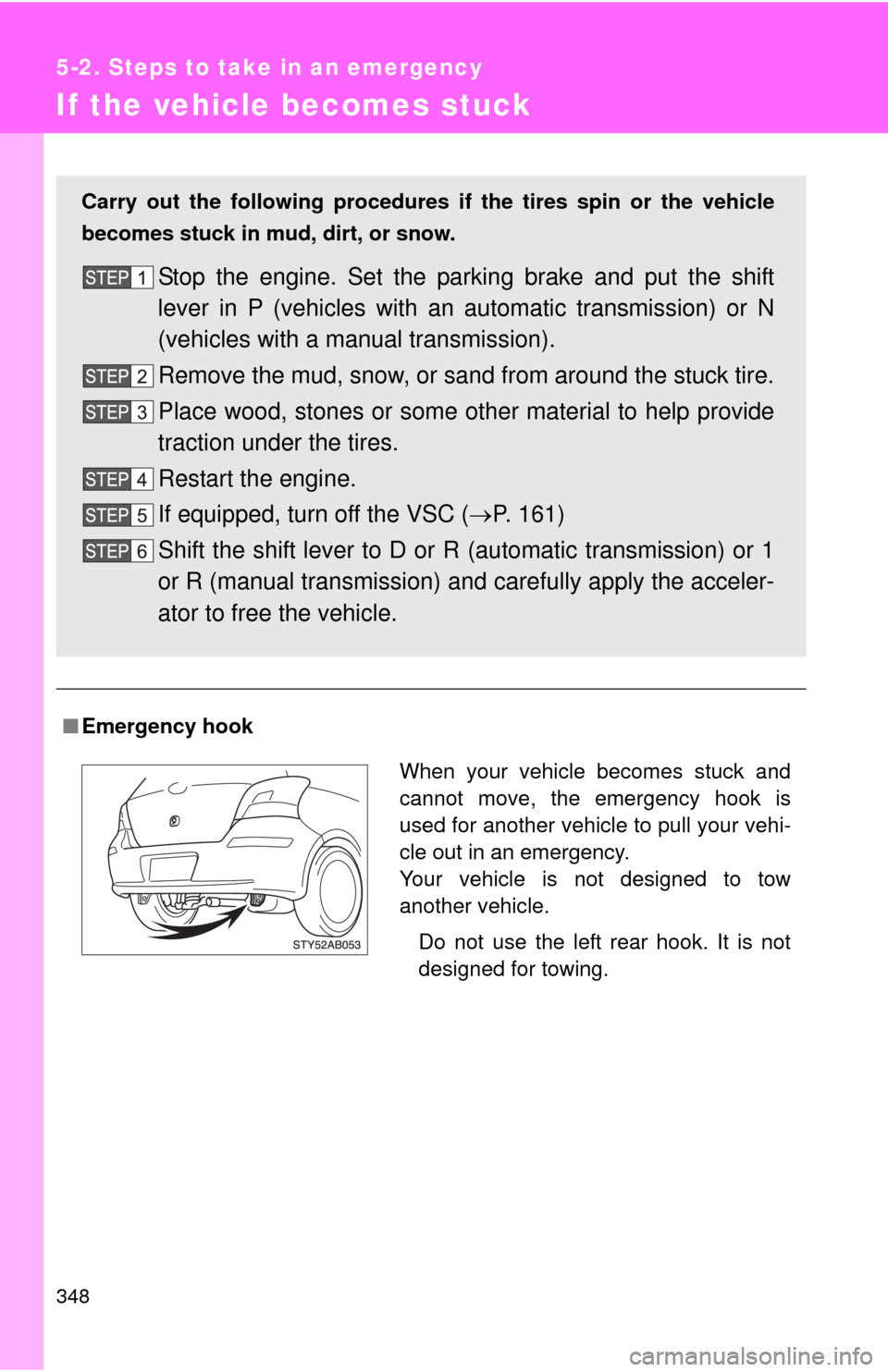
348
5-2. Steps to take in an emergency
If the vehicle becomes stuck
■Emergency hook
Carry out the following procedures if the tires spin or the vehicle
becomes stuck in mud, dirt, or snow.
Stop the engine. Set the parking brake and put the shift
lever in P (vehicles with an automatic transmission) or N
(vehicles with a manual transmission).
Remove the mud, snow, or sand from around the stuck tire.
Place wood, stones or some other material to help provide
traction under the tires.
Restart the engine.
If equipped, turn off the VSC (P. 161)
Shift the shift lever to D or R (automatic transmission) or 1
or R (manual transmission) and carefully apply the acceler-
ator to free the vehicle.
When your vehicle becomes stuck and
cannot move, the emergency hook is
used for another vehicle to pull your vehi-
cle out in an emergency.
Your vehicle is not designed to tow
another vehicle.
Do not use the left rear hook. It is not
designed for towing.
Page 349 of 400
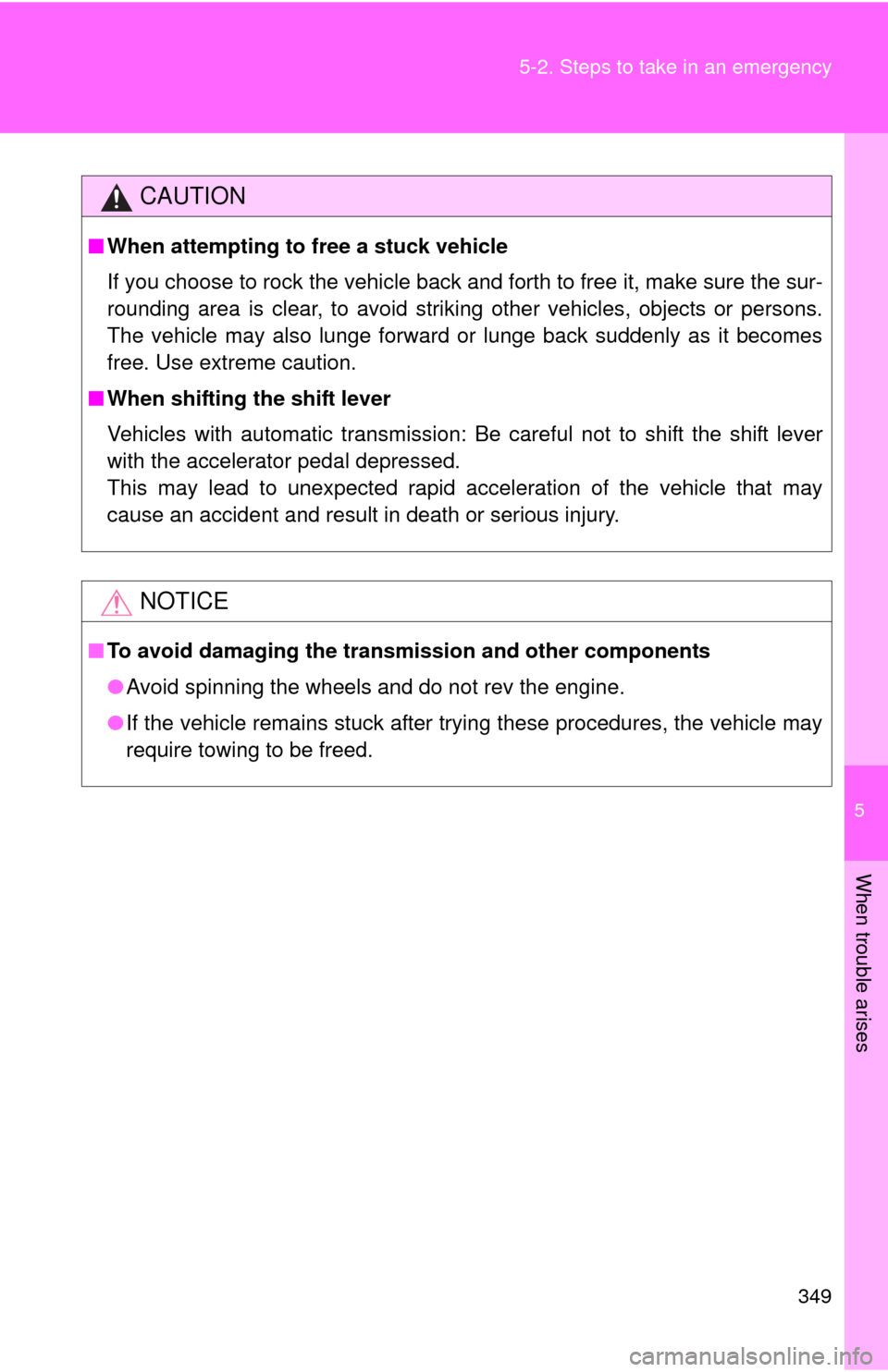
5
When trouble arises
349 5-2. Steps to take in an emergency
CAUTION
■When attempting to free a stuck vehicle
If you choose to rock the vehicle back and forth to free it, make sure the sur-
rounding area is clear, to avoid striking other vehicles, objects or persons.
The vehicle may also lunge forward or lunge back suddenly as it becomes
free. Use extreme caution.
■When shifting the shift lever
Vehicles with automatic transmission: Be careful not to shift the shift lever
with the accelerator pedal depressed.
This may lead to unexpected rapid acceleration of the vehicle that may
cause an accident and result in death or serious injury.
NOTICE
■To avoid damaging the transmission and other components
●Avoid spinning the wheels and do not rev the engine.
●If the vehicle remains stuck after trying these procedures, the vehicle may
require towing to be freed.
Page 395 of 400

395 Alphabetical index
Fog lights switch ................... 151
Hazard lights switch ............. 304
Ignition switch ....................... 129
Headlights switch ................. 149
Light switch........................... 149
Power door lock switch........... 32
Power window switch ............. 71
Turn signal lights .................. 135
VSC OFF switch ................... 162
Window lock switch ................ 72
Wiper and washer ........ 152, 155
Tachometer .............................. 139
Tail lights
Indicator................................ 149
Replacing light bulbs ............ 294
Switch ................................... 149
Wattage ................................ 360
Theft deterrent system
Alarm ...................................... 80
Engine immobilizer system..... 78
Theft prevention labels ........... 82
Theft prevention labels ............. 82
Tire inflation pressure ............ 272
Tire information
Glossary ............................... 371
Size ...................................... 368
Tire identification number ..... 367
Uniform tire quality
grading ............................... 369
Tires
Chains .................................. 169
Checking .............................. 266
If you have a flat tire ............. 325
Identification number ............ 364
Inflation pressure .......... 272, 359
Inflation pressure sensor ...... 267
Information ........................... 364
Replacing ..................... 266, 325
Rotating tires ........................ 266
Size ...................................... 359
Snow tires............................. 169
Spare tire .............................. 325Tire pressure warning
system ........................266, 318
Warning light .........................318
Tools .........................................325
Total load capacity...................168
Towing
Dinghy towing................181, 182
Emergency towing.................305
Trailer towing.................172, 173
Trip meter .................................142
Turn signal lights
Indicator ................................135
Lever .....................................135
Replacing light bulbs .............294
Switch....................................135
Wattage .................................360
Vanity mirrors...........................228
Vehicle identification
number ...................................353
Vehicle stability control...........160
VSC............................................160
Warning buzzers
Brake system ........................315
Seat belt reminder .................318
Warning lights
ABS .......................................316
Airbag system .......................316
Anti-lock brake system ..........316
Brake system ........................316
Charging system ...................316
Driver’s seat belt ...................318
Electric power steering
system ................................316
Electronic engine control
system ................................316
Engine oil replacement..........318
EPS system...........................316
Front passenger occupant
classification system ........... 316
Front passenger’s seat belt ...318
T
V
W